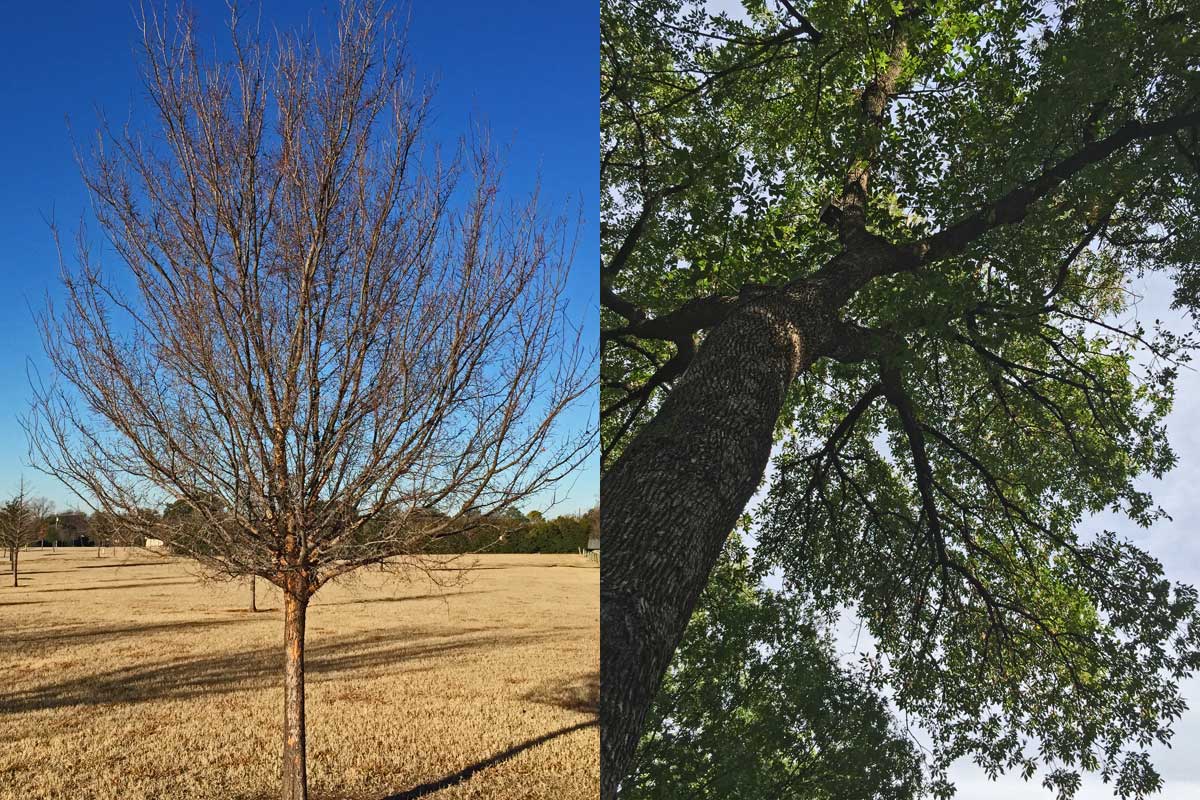Trees are great. Who doesn't love trees? They are both beautiful and functional and can help enhance any property or garden. Want proof of that? Take a drive through the nicest neighborhood in your area and it's likely that the boulevards and homes are lined with mature trees.
If you are thinking of planting a tree or maybe several in your landscape and garden, here are five important factors to consider when selecting or planting a new tree for your property.
1. Size and Scale
The most important factor about selecting a tree would be consider the eventual size and scale of the tree and how big it will grow in maturity. Selecting the right tree for the size of the property and garden will insure that the tree will perform well and will not have any limits put on it's growth, size and shape. It makes no sense to plant a tree in a location where it will not thrive and grow successfully.
All too often, we see homeowners and landscape professionals alike planting the wrong trees in the wrong location and the trees then grow into their mature size and often don't fit the space. This can result in the tree growing in an awkward shape or manner in order to fit and adapt to the space. One of the most common mistakes we see is when trees are planted too close to houses or buildings, which can restrict the growth of the tree and often do damage to the house and structure. If you have or know anyone who has ever needed foundation repair for their home, it is likely that tree roots might be one of the main causes. Their roots can expand beneath the foundation of a house and cause the slab to lift as well as doing damage to the plumbing lines. Damage can also be done by trees and branches that overhang roofs and power lines. As we enter the spring storm season, listen to the local news about winds and trees can cause damage to roofs and be the cause for downed power lines.
Think about the eventual size and scale of a tree when you plant and try to locate a mature tree of the same kind and variety and see how it has grown over the years and how much room it often needs to thrive. Consider how it will grow in relation to it's surrounding and other nearby trees.
2. Location & Placement
As with real estate, location, location, location is another important factor to consider for new tree planting. The location of the tree will often be the greatest factor of success for the tree and it's establishment. Locating a tree involves not only thinking about it's eventual size and scale, but should also factor in other site conditions such as sun orientation, wind protection and privacy.
The proper light and exposure to the sun will give the tree the fuel it needs to flourish. With flowering and blooming trees, the sun is even more important to help the blooms flourish. Crape myrtle trees for example, will provide colorful blooms throughout the summer as long as they receive ample sunlight. Plant one in the shade or with restricted light and the blooms will be much less profuse and vibrant.
Shade and protection from the sun are as equally important for other trees which have more delicate leaves and flowers. Japanese Maples and Dogwoods are a couple ornamental trees that must have some filtered shade and protection from the direct sun. Otherwise their leaves will suffer from sun scorch.
The placement of trees can also be a vital advantage and improvement for a residence when properly located. Trees planted on the western exposure of a home can offer protection from the hot Texas sun and can actually save you money on your air conditioning bill in the summer. A similar gain can be achieved in the winter, by planting deciduous trees near windows where the sunlight can spill into the windows of a home and provide some warmth for the home.
Protection from the wind is another advantage that proper tree planting can provide. If you have ever been to West Texas or Oklahoma, you are familiar with the wind and how it can pierce right through you on those colder days. Placing evergreen trees such as Eastern Red Cedar or Leyland Cypress trees in a row, can provide a wind break that can provide shelter from those winds when entering or leaving a building.
Privacy and screening are another important and valuable factor in tree placement. One of the many requests and requirements we get when designing gardens, is to provide screening for our clients from adjacent houses and undesirable views. This is usually a mandatory requirement for the suburban homes in the Dallas area with the density of homes. Especially when putting in an outdoor room or swimming pool, adding evergreen screen trees along the fence line can provide you a bit of privacy from that nosy neighbor. Savannah Holly and Magnolia trees are often popular choices for this purpose.
3. Deciduous or Evergreen
When choosing the right tree you should also consider whether the tree is deciduous (loses it's leaves each season) or evergreen (keeps it's leaves through the winter.) Both deciduous and evergreen trees have their own advantages. Deciduous trees will change with the season, offering spring and fall color as well as allowing sunlight to pass through in the colder winter months. Evergreen trees are often selected for their year round leaves to help provide privacy and screening as well as protection in the colder months.
A mixture of the two types of trees is what we usually like to include in our designs. Using evergreen trees in the background can often provide an attractive visual to the deciduous trees and enhance the seasonal changes and fall color. For example, October Glory Maple trees planted along side Magnolia or Live Oak trees can provide a striking color contrast in the fall.
4. Spring, Summer or Fall (and Even Winter) Color
Trees can often steal the show in a garden when it comes to spring and fall color. Flowering shrubs and perennials usually draw the focus for most gardeners, but the trees are the framework for the garden and can make an equally as impressive show.
A good garden design will include a blend of shrubs and trees that provide year round color. Spring blooming trees such as the purple blooms of the Redbud, the white flowers of the Pear tree and the gorgeous white and pink flowers of Dogwood trees get the garden off to a great start. Summer color can be provided by the many colors of Crape Myrtle trees (red, lavender, pink, and white) are available along with the purple blooms of Vitex trees and the delicate pink colors of a Desert Willow. Autumn can then bring a wonderful show of colors ranging from the deep reds from Red Oaks and Pears as well as the vibrant oranges and reds of the Sweetgum and October Glory Maples trees as well as the vivid yellow and golds of the Ginkgo Trees.
Let's also not forget the winter season which can certainly use the help from trees such as Deciduous Holly and Coral Bark Japanese Maple. Do your self a favor and plant a mixture of trees that will provide interest year round for your garden.
Check out a few of our Pinterest boards for Best Trees for Spring Color, Best Trees for Fall Color and Ornamental Trees for Fall Color.
5. Purpose
Don't just plant a tree haphazardly. Avoid the typical builder tree planting that you see in the suburbs where a home builder will just stick in the cheapest tree possible in the middle of the yard. It often looks ridiculous, especially when your neighbors have the same tree in the same spot.
Plant it for a reason and a purpose. it can be for any number of reasons as we have discussed above such as to provide shade, spring or call color, screening and privacy, wind protection and environmental enhancements for your home. The real artistry is to plant a tree that will achieve many of these benefits while creating a visually attractive look for your property and can enhance the value of your property over time.
Bonus #6. Container Grown or B&B (Balled and Burlap)
One more tip to consider when selecting or buying a tree is whether the tree is container grown or b&B (balled and burlap). Container grown trees are grown in an nursery from and moved into larger containers as they grow in size. The main advantage of container trees are that they retain their entire root structures as they move from container to container at the nursery which means that their will almost always be healthier when planted and will grow more rapidly when planted. They can usually be planted in a broader time window during the year as they are not as subject to digging and root damage as b&b trees.
Planting b&b trees is often the preferred method for landscape professionals since the sizes avaiable are greater since they are usually field grown or transplanted. Most nurseries don't grow container trees over a certain size. B&B trees are the best method for digging established trees. However, they can often present more challenges in that the some of the roots must be cut in order to create a root ball that can then be wrapped and transplanted. B&B trees are also more restricted to the seasons for planting in that the tree should be dormant while digging so the roots and health of the tree are not damaged in the planting process.
Consult with your Landscape Architect or landscape professional to determine the best method and time for your tree planting.
Get busy. The mild temperatures of spring are passing by and then the heat of the summer will arrive and you will likely need to wait till the fall to do any tree planting.



